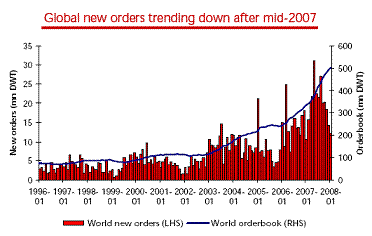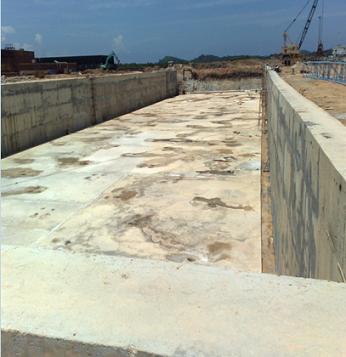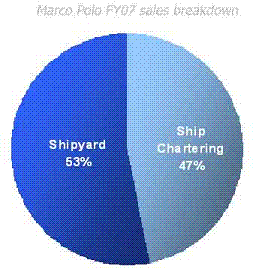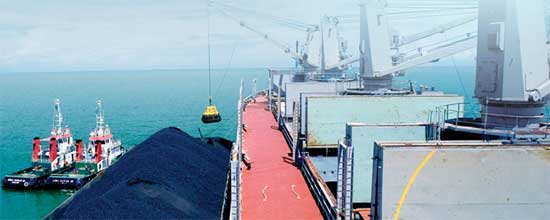
Source: DBS Vickers / Clarksons
SHIPOWNERS FIGHTING for yard space when they placed new vessel orders in the past 5 years will fight even harder for space come dry-docking time for vessels delivered over 2005-2012.
”Ship repair will be our next earnings driver,” said Sean Lee, 30, the chief executive of Marco Polo Marine, an integrated shipping group with ship chartering and shipyard businesses. NextInsight and eight analysts from Singapore visited Marco Polo's yard in Batam recently.
Newbuilding orders peaked at 31 million dwt in May 2007, according to UK-based shipbroker Clarksons.
Even though the newbuilding cycle is slowing down, shipyards with dry docks will still ride the repair boom that inevitably follows a newbuild boom.
As corrosive marine life inevitably accumulates on ship hulls during seaborne voyages, vessels need to be dry-docked for cleaning and re-painting at least once every 3-5 years.
The waiting time for drydock space can now be as long as 3 months, a couple of shipyard owners told NextInsight.
There is a shortage of repair facilities owing to the emphasis that shipyards have placed on expanding shipbuilding capacity because a newbuilding contract is usually valued in tens of millions of dollars versus a repair job of a million dollars or less.
Repair facilities such as drydocks at Marco Polo take about a year to build.
Other than space shortage, a second boon to repair yards now is that unlike the cyclical capital expenditure cycle of shipbuilding, the ship repair business is a relatively stable one, with recurrent income streams.
Financially, it is also more lucrative: operating margins before interest, taxes and depreciation (EBITDA margins) can be as high as three times that of shipbuilding.

Marco Polo’s first dry dock on its 34-ha Batam yard will be operational next month.
Properly known as ‘graving dock’, Marco Polo’s drydock is a box-shaped concrete basin 150 meters in length, 40 meters wide and 8 meters deep. It cost $5.5 million to construct.
A second drydock (175 X 40 X 8.5 meters) is being constructed and will be completed in September 2009 at a cost of $10 million.
The plan is for its drydocks to accommodate up to 5 vessels of varying lengths between 50 meters and 130 meters.
Young shipyard with lofty ambitions
Marco Polo's latest shipbuilding order was announced this week – a S$74.5 million contract to build a 80-meter DP2 subsea operations vessel for Hallin Marine.
Established in Dec 2005, the shipyard started by building tugs and barges, and has delivered 53 such vessels to date.
The company was listed on 5 Nov 2007 on Catalist at an IPO issue price of 28 cents. Its current market cap is about S$65 million.
Revenues for the financial year ended 30 Sep 2007 were S$37 million and net margins were 22.6%.
It has since progressed into clinching orders for 4 anchor handling tug supply vessels.
Outstanding shipbuilding orders are for 16 vessels amounting to S$113.1 million, triple its FY07 revenues.
Why was it able to grow so quickly, taking a fraction of the time that larger yards took?
Firstly, most of its tugs and barges are constructed for its own shipping segment (13 out of 24 in 1H08).
Secondly, several senior managers from Pan-United Marine were recruited by Marco Polo after Dubai Drydocks World took over the leading AHTS builder last year.
With their wealth of experience, the young yard hopes to eventually handle the more complicated vessel conversion jobs.
Shipyard operations contributed S$7.4 million or 45% of Marco Polo’s sales for the first 6 months of their financial year ended 31 March 2008.
Strong connections

Mr Sean Lee’s family, which owns 75% in Marco Polo, also controls a much larger business, the BRJ Group, in Indonesia’s mining, construction, property development and infrastructure sectors.
Due to transshipment requirements of coal and granite mix aggregates mined from BRJ’s quarries, the management has dealt with ship chartering for over 15 years.
Marco Polo was formally appointed as BRJ’s exclusive ship charterer for 2 years commencing from 13 Sep 2007, and is a specialist in transshipment of mineral ores within Indonesia.
For several years now, the company has been operating a fleet of tugs and barges at close to full utilization.
Now at 31 vessels, its fleet size is expected to increase to 37 vessels by end 2008 (1Q09).
Ship chartering contributed S$9.1 million or 55% to 1H08 sales.
BRJ is not its only strong alliance.
It recently set up a joint venture with Glencore (one of the largest suppliers of commodities and raw materials) for the transshipment of the latter’s cargo.

Related story : ASL MARINE: Riding The Wave Of Shiprepair Boom






